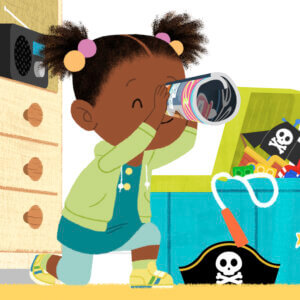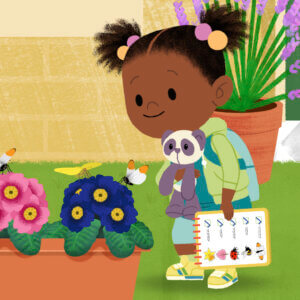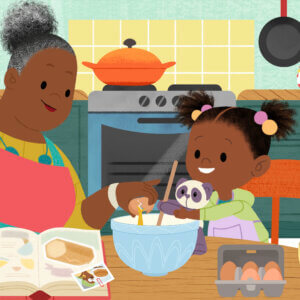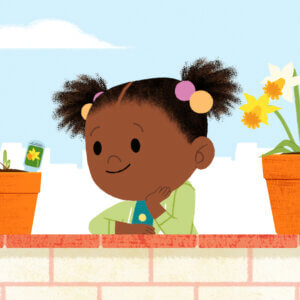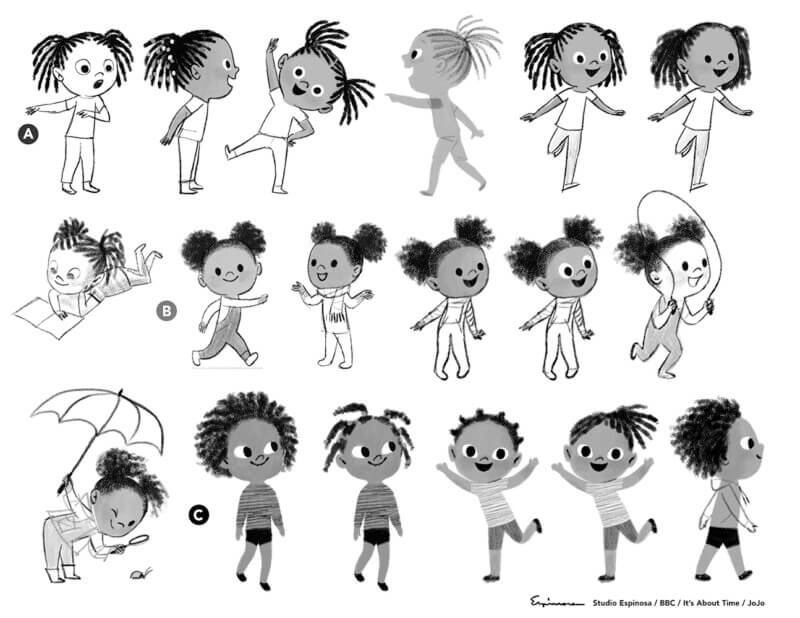JoJo & Gran Gran – Interview with the team behind CBeebies latest hit!
Following a successful book launch from author Laura Henry, Jojo and Gran Gran was swept up into a TV adaptation on CBeebies which has given these characters new animated life. BBC Children’s In House Productions produced this new show with A Productions and as well as being a fun, warm and charming series, it’s also the first-ever British animated series focusing on a black family.
We got to sit down with Tom Cousins, the series producer, Katherine McQueen, Managing Director of A Productions and Ros Attille, a preschool development executive at BBC Children’s. We cover everything from the series initial roots, the R&D process, design through to the process of adapting the series from the book.
For those who don’t aren’t familiar, can you tell us a bit about JoJo & Gran Gran?
Tom Cousins: JoJo & Gran Gran is a show about the everyday adventures of a four-year old girl who is cared for by her fun, wise Grandmother whilst her parents are at work. The show really celebrates a special bond between children and their grandparents and it’s also the first animation on CBeebies to focus on a black family.
Ros Attille: When we first started developing the show, it was called “It’s about Time” and so the other really important element that is still there is that it tries to take a concept as something as abstract as time and tries to break it down into much smaller, comprehensible pieces for little ones. It’s trying to explain time as a concept rather than “telling the time”.
The show feels very personal and heartwarming, what personal inspirations did you take from, both culturally but also from your own personal families and stories?
RA: For me, it was very much about in Caribbean culture, grandparents are so so important and the fact that on CBeebies it’s all about children and so much of children’s lives are about their parents and about their family and their extended family. Grandparents are so important to that culture. It was just really nice to take that element and celebrate it.
TC: I think also, the show is inspired by a book series called JoJo & Gran Gran, written by Laura Henry Allan, those two characters are loosely based on Laura’s own childhood. Gran Gran is her Gran and Laura’s herself. Laura came to development and Ros helped develop that format.
RA: Yeah, the book had been lying around in the office for quite a while and it hadn’t been picked up and it had been passed over. I saw it and I thought there was something here and something really heartwarming about that relationship and the Caribbean culture. My parents are also from St. Lucia so it really resonated within me. The central thing is that really loving relationship between the grandmother and the granddaughter which I think resonates not just with Caribbean people but with everybody.
TC: I think also, when I joined the project it had been pitched and commissioned and it’s my job to scale it up and make it into a show and bring all the talent onboard. My first day on the job was at a writers workshop and Ros was there, Laura was there and Omari (McCarthy, who wrote an episode) was there as well. I had a really good conversation with Laura, and what became really clear was that family, love, culture, history were all really really core themes to Laura and so for me, right, how can we put as much of that as possible into the show and that fuelled the difference in design from the book to the show.
Katherine McQueen: Yeah, what was really important for us and we were lucky to work on this show with BBC was the fact that through our discussions even at pitch level, in discussing people within the Caribbean community in Bristol where we’re based was how they wanted to see themselves represented on screen and there was nothing for them they felt really did. What we wanted to do was put little nuanced things on there, there’s a special pot that’s on the stove, there’s little elements in the show that aren’t a story piece, they’re not narrative drivers but they’re in the background to really give a foundation to the kind of family life and what we’re trying to represent. And that can be from the baby photos that a Grandma will have on the wall to a specific pot or a specific fruit in a fruit basket.
TC: Through the early pre-production, something there was a definite opportunity to do was make something feel contemporary and make it feel like it was set in a real place. So, about a year ago I went for a walk around Paddington Recreation Ground and took loads of reference photos there and created a big moodboard of areas of London that we wanted to feel contemporary. We never say the word “London” but if you’ve grown up in London or a Southern British city, you’ll recognise bits of architecture. In animation, it’s often that you have very global feelings for things that will sit in different countries. I’m very confident this will sit in different countries but it’s been designed to be very specifically British and to feel very rooted in a reality that hopefully kids at home will recognise and I think that’s a very special thing.
KM: I think we got lots of ideas when we were working with a panel which we run a lot of the production processes through. So, we have a panel that inputs at script stage that’s made up of from Bristol and what’s been really helpful is that they’ve said “Oh my Grandmother had this when I was a kid” or “we used to do this” and what’s been really nice is when these comments have come in, the design team have picked those little bits out and that’s what they’ve drawn up in the landscapes, the house and the interiors that create that sort of world.
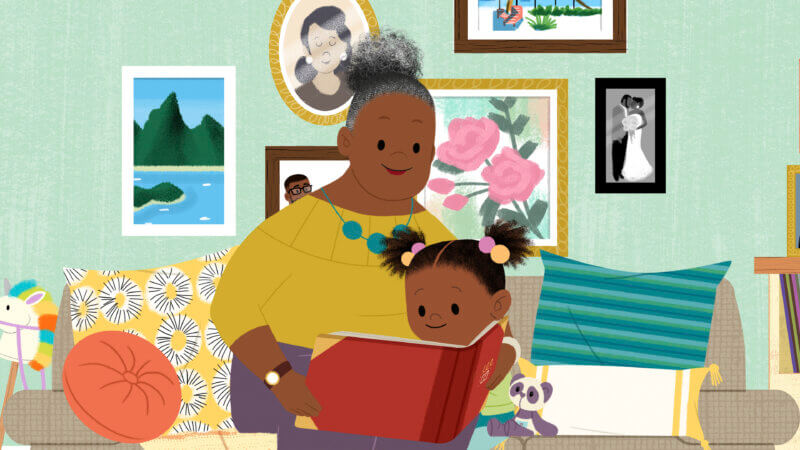
Amazing! So, obviously, the style does differ from the books. Despite being so different in style, they both give a very personal warmth to them. What was it about the style that you wanted to go with?
TC: When I joined the project, there’d been an animation test done with the original style and I think there was a few different reasons behind the development of that style. One of the reasons was that there were a couple shows that had already been commissioned on CBeebies that I felt looked quite similar and there’s such an opportunity, because animation is such a visual medium, there’s an opportunity to create something distinct and unique. So, that was number one reason. The second thing was, talking to the development team, design team and talking to Laura as well. Ideas starting forming around a sense of place and how we can celebrate Afro-textured hair, so the word texture became really important. I put together a moodboard inspired by mid-century artists like Mary Blair, Tibor Gergely, Shirley Hughes and Mary Hoffman. So, it’ll be a lot of texture and poster paint but, if we move that into a contemporary setting, that’ll give us that sense of detail and texture that becomes a really unique thing that will hopefully stand out. One thing I’m really really quite proud of and pleased of is that from that moodboard, we commissioned two illustrators to create concept art and key artwork for the series which is what we used when we were meeting animation companies to come on board. I’m so pleased that A Productions have managed to stay true to that original look, it’s elevated and different.
KM: I think from our perspective, keeping that look and keeping it illustrative rather than a “cartoon” was really important. What we tried to do is keep the elements of the line, the hair, the way that the textures move across the body, move within the clothing and how they sit. So that, if you pause it and it’s still, it can still look like an illustration from a book rather than thinking “Oh! That’s a screengrab from a TV show!”.
TC: There were very distinctive creative decisions that have been made on the production. It should always look like a book illustration. You get a lot of proscenium art staging, there’s lots of amazing brush work that’s been done within the rigs and the texture of the show, but if you watch it again, in the background, you’ll see details that are in there, and the style we chose enabled us to do that. With the design, we chose this style but the one area where we had a bit of a stumbling block was the character of Gran Gran because we wanted to keep the character as a young grandmother, not elderly or with a walking stick. We wanted to create a reality of modern Britain. A lot of Grandparents are caring for their Grandkids and they’re really active and they’re not represented. The more people we spoke to, who were of that age, the more they said “Yes! I’m so annoyed of seeing Grandparents on TV represented in a really stereotypical way”. But we’ve chosen a style that is very illustrative, very smooth, very stylised.
TC: So, there were early conversations about how do we make this character, not look like a Mom or a 35/45 year old woman. We don’t want to give her a walking stick, we don’t want to use those signifiers that you usually would for a Grandma but we can’t really use aging on the face, so what can we do? So, there were lots of conversations about body shape and, something about pre-production that I don’t think people think about is the actors. So, Cathy Tyson really brought that character to life and when you hear her performing, you say “Oh! Of course this is going to work”, so there’s lots of moments where we thought “Oh is this going to work?” and then we’d get to the next stage of it and it all falls into place. But that was the original challenge with this design, JoJo was a relatively quick design, Gran Gran took some time.
Obviously, with the show being aimed at children, that style works very well for that audience. Was there anything else you had to keep in mind from an audience perspective when developing this?
RA: Yeah, so it’s my job actually just to develop all the CBeebies in house productions. So essentially, we’re coming up with lots and lots of ideas all the time. And a lot of the time, what we’re doing is we’re looking at what’s out there. So you know, what’s on the channel? And what’s missing? What is it that matters in children’s lives? So, I think prior to development work on this, I talked with some schools and some parents and I kind of said, you know, what are your children talking to you about what do you feel is kind of like, the most prevalent conversations at the moment and, and one of the things they talked about was identity. So, for me, it kind of felt that you know, JoJo and Gran Gran was a good project to actually kind of just showcase that whole thing about identity. So, no, so it felt like it was a good fit. But, yeah, a lot of the time, that’s what matters to children, particularly, I mean, this is a very, very particular time that we’re living through. And also, doing the whole thing about time, nobody had done that. So basically you have to put in what you think will you know sway a commissioner what will “WOW!” that Commissioner. If nothing’s ever been done like this before, then absolutely, you just hope that the more unique things you have about it, the more likely that it’s going to end up fly.
JoJo & Gran Gran is currently airing on CBeebies. Catch the latest episodes here.


